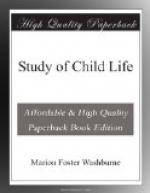(2) Sympathy is much more likely to rise spontaneously in the mother’s breast for the child’s troubles than for the child’s joys. She will stop to take him up and pet him when he is hurt, no matter how busy she is, but she too often considers it waste of time to enter into his plays with him; yet he needs sympathy in joy as much as in sorrow. Her presence, her interest in what he is doing, doubles his delight in it and doubles its value to him. Moreover, it offers her opportunity for that touch and direction now and then, which may transform a rambling play, without much sequence or meaning, into a consciously useful performance, a dramatization, perhaps, of some of the child’s observations, or an investigation into the nature of things.
(3) Right Material. Even given freedom and sympathy, the child needs something more in order to play well: he needs the right materials. The best materials are those that are common to him and to the rest of the world, far better than expensive toys that mark him apart from the world of less fortunate children. Such toys are not in any way desirable, and they may even be harmful. What he needs are various simple arrangements of the four elements—earth, air, fire and water.
[Sidenote: Mud-pies]
(1) Earth. The child has a noted affinity for it, and he is specially happy when he has plenty of it on hands, face, and clothes. The love of mud-pies is universal; children of all nationalities and of all degrees of civilization delight in it. No activity could be more wholesome.
[Sidenote: Sand]
Next to mud comes sand. It is cleaner in appearance and can be brought into the house. A tray of moistened sand, set upon a low table, should be in every nursery, and the sand pile in every yard.
[Sidenote: Clay]
Clay is more difficult to manage indoors, because it gets dry and sifts all about the house, but if a corner of the cellar, where there is a good light, can be given up for a strong table and a jar of clay mixed with some water, it will be found a great resource for rainy days. If modeling aprons of strong material, buttoned with one button at the neck, be hung near the jar of clay, the children may work in this material without spoiling their clothes. Clay-modeling is an excellent form of manual training, developing without forcing the delicate muscles of the fingers and wrists, and giving wide opportunity for the exercise of the imagination.
[Sidenote: Digging]
Earth may be played with in still another way. Children should dig in it; for all pass through the digging stage and this should be given free swing. It develops their muscles and keeps them busy at helpful and constructive work. They may dig a well, make a cave, or a pond, or burrow underground and make tunnels like a mole. Give them spades and a piece of ground they can do with as they like, dress them in overalls, and it will be long before you are asked to think of another amusement for them.




